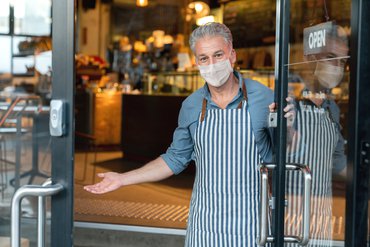The Small Business Administration is encouraging restaurant operators to apply for grants through the Restaurant Revitalization Fund as soon as the application period opens, said presenters at a webinar about the application process on Tuesday.
The webinar was presented by the Independent Restaurant Coalition, a group formed during the pandemic to advocate for federal relief for the restaurant industry.
Exactly when the application process will begin is still up in the air however, said Patrick Kelley, associate administrator at the SBA, who said preparations for launch are in the “final stages.” The SBA will soon conduct a one-week test of the application with a limited number of small businesses that will be invited by the organization to participate, before applications are opened up to the business community at large.
Online applications will be available through a special area of the SBA website and will also be available through companies that provide point-of-sale systems to restaurants, in an effort to make the application process easier.
“Everyone should apply on day one,” said Kelley. “In all likelihood, at the end there will be applications that are eligible but will not be funded” because the $28.6 billion allocated for the grants will run out.
At that time, Congress could decide to add more funding, he pointed out, and legislators will be encouraged to do so if they see strong demand from the small business community.
The funding will include $500 million set aside for very small businesses—those with 2019 revenues of $50,000 or less—and another $5 billion will be provided for businesses that had no more than $500,000 in 2019 revenues. Another $4 billion has been set aside for businesses with more than $500,000 in revenues but less than $1.5 million.
The grant program will prioritize in the first 21 days businesses that are at least 51 percent owned by women, military veterans, and economically and socially disadvantaged groups, which includes people of color. Applicants will be asked to “self-certify” that they belong to one of these groups, but will not need documentation to prove that they meet these criteria, the presenters said.
Also, any ownership by individuals who are members of these groups can be combined to reach the 51-percent threshold. Thus, if a woman and veteran each own 30 percent of a company, their combined ownership of 60 percent qualifies them for prioritization.
Restaurant chains with 20 locations or less will be eligible, as will franchisee-owned restaurants, food trucks, food stands, tasting rooms, brewpubs, coffee shops, ice cream shops, and just about any place else food served.
Exceptions are government-owned entities and nonprofits, and entities that have “permanently closed.” The latter includes companies that are liquidating through bankruptcy, although companies that are restructuring though bankruptcy are eligible.
Businesses that have closed temporarily because of the pandemic are eligible, as are businesses that incurred pre-opening expenses during the covered period—between Feb. 15, 2020, and March 11, 2021—but never opened their doors.
The presenters also pointed out that the time limit for spending the grants has been extended until March 11, 2023, rather than the end of 2021, as was first proposed.
Julie Verratti, also an SBA associate administrator and the co-founder of Denizen's Brewing in Silver Spring, Maryland, said the extension of the time that funds may be spent was “one of the best decisions made” about the program, given the unpredictable nature of the economic recovery and restaurant reopenings.
“It has been exhausting to run a restaurant this past year … [with] the constant pivoting,” she said. “This is just one way to prevent another pivot.”
Expenses that are eligible to be paid for using the grants include any business operating expenses, such as rent, payroll, utilities, maintenance expenses, construction of outdoor seating, supplies, and principal and interest payments on a mortgage, among others.
“The guiding principle is: As much relief to as many businesses in as short an amount of time,” said Kelley.
In order to calculate their grant amount, operators have three different formulas they can use, based primarily on when their business opened:
• Restaurants that opened before Jan. 1, 2019 should take their 2019 gross revenues and subtract their 2020 gross revenues, then subtract any loans received through the Paycheck Protection Program. The net result will be the grant amount they are eligible to receive.
• Operators that opened during 2019 have two options. They can calculate what their revenues would have been in the full year 2019 by multiplying their average monthly revenues by 12, then subtracting 2020 revenues and then subtracting their PPP loan totals, or
• Operators that opened in 2020 (or those that opened in 2019 if they choose this option) can calculate their grant by adding all of their expenses from Feb. 15, 2020 through March 11, 2021, and then subtract their revenues for 2020 and 2021 through March 11, and then subtract the amount of any PPP loans.
Restaurants that opened in 2019 can chose between the second and third options based on which yields the higher grant, Kelley explained.
In order to verify that they are eligible, operators ideally will have filed their tax returns for 2019 and 2020, but other documentation will be accepted, such as income statements and bank records.
Related: Restaurant Relief Fund Injects Optimism Into Industry; Employee Retention Tax Credit: What You Should Know.

